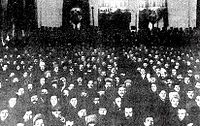- All-Russian Congress of Soviets
-
All-Russian Congress of Soviets
Всероссийский Съезд СоветовType Type Congress of Soviets Timeline Country  Russia
RussiaEstablished 1917 Preceded by Russian Provisional Government
Russian Constituent AssemblySucceeded by Supreme Soviet of Russia Disbanded 1937 Members Varies in every congress:
- 1090 at first (I) Congress
- 1338 at last (XVII) congress
Election Voting system Indirect elections Meeting place 
Second All-Russian Congress of Soviets (November 7-9) in Petrograd, Smolny
The Congress had no permanent location.The All-Russian Congress of Soviets was the supreme governing body of the Russian Soviet Federative Socialist Republic from 1917-22 and of the Soviet Union until 1936. The 1918 Constitution of the Russian SFSR mandated that Congress shall convene at least twice a year. The 1925 constitution lowered the minimum to once a year.
Contents
History
First Congress
The First All-Russian Congress of Soviets of Workers 'and Soldiers' Deputies (June 16 - July 7, 1917) was convened by the National Conference of the Soviets. It was dominated by pro-government parties (Socialist-Revolutionaries, etc.) and confirmed the supremacy of the Russian Provisional Government.
Second All-Russian Congress
Following the overthrow of the Provisional Government of Russia in the October revolution, the Second All-Russian Congress of Soviets of Workers' and Soldiers' Deputies (November 7-9, 1917) ratified the revolutionary transfer of state power. The Menshevik and Socialist Revolutionary deputies walked out in protest.
Third Congress
The Third All-Russian Congress of Soviets of Workers', Soldiers' and Peasants' Deputies (January 23-31, 1918) was attended by delegates from 317 Soviets of Workers', Soldiers' and Peasants' with a further 110 delegates from army, corps and divisional committees. The Bolsheviks comprised 441 of the 707 delegates. On the fourth day January 13 (26), more delegates who had been at the Third All-Russia Congress of Soviets of Peasants' Deputies arrived. By the end there were 1,587 delegates.
The Congress had a Praesidium composed of ten Bolsheviks and three Left Socialist-Revolutionaries with a further delegate from each other group (Right Socialist-Revolutionaries, Mensheviks, etc.)
The Swiss, Rumanian, Swedish and Norwegian Social-Democratic parties, the British Socialist Party and the Socialist Party of America sent messages of solidarity.
Occurring shortly after the Constituent Assembly had been dissolved by order of the All-Russian Central Executive Committee (VTsIK), the Congress resolved to expunge any references to the forthcoming Constituent Assembly from all new editions of decrees and laws of the Soviet Government. The Congress received:
- Yakov Sverdlov's report on the activity of the All-Russian Central Executive Committee.
- Vladimir Lenin's report on the activity of the Council of People's Commissars.
- Joseph Stalin's report from the People's Commissariat of Nationalities on the principles of federation and the nationalities' policy for the emerging Soviet state. The nationalities policy was agreed.
The Mensheviks, Right Socialist-Revolutionaries and the Menshevik internationalists used the Congress to indicate their opposition to the domestic and foreign policy which the Bolsheviks passed. The Declaration of Rights of the Working and Exploited People was passed and this went on to become the basis of the Soviet Constitution. It was also agreed to establish the Russian Soviet Federative Socialist Republic on the basis of a free union of the peoples of Russia. The Congress also approved the Decree on Land which provided the basic provisions of the redistribution and nationalization of land.[1]
Fourth Congress
At the Extraordinary Fourth All-Russia Congress of Soviets (March 14-16, 1918), the Treaty of Brest-Litovsk was ratified.[2]
Fifth Congress
The Fifth All-Russia Congress of Soviets of Workers’ Peasants’, Soldiers’ and Red Army Deputies was held July 4-10, 1918.
Sixth Congress
The Extraordinary Sixth All-Russia Congress of Soviets of Workers’, Peasants’, Cossacks’ and Red Army Deputies was held November 6-9, 1918.
Seventh Congress
The Seventh All-Russia Congress of Soviets of Workers’, Peasants’, Cossacks’ and Red Army Deputies was held December 5-9, 1919.
Erasure
The Congress ceased to exist at the end of the constitutional reform of 1936-1937, when the first on the union and then at the republican levels indirect election to Soviets were replaced by direct elections at all levels with the Supreme Soviet as the highest body.
Election
See also: Democratic centralismThe Congress was formed of representatives of city councils (soviets) (1 delegate per 25,000 voters) and the congresses of the provincial (oblast) and autonomous republican council (1 deputy for every 125 thousand inhabitants).
Powers
The exclusive jurisdiction of the Congress consisted of:
- Election of the All-Russian Central Executive Committee
- Adoption of the Constitution of the Russian SFSR and amendments to it.
- Approval of amendments proposed by VTsIK
- Approval of the ASSR's constitution
On the other issues the Congress and Central Executive Committee had the same authority.
References
- ^ Third All-Russian Congress of Soviets of Workers', Soldiers' and Peasants' Deputies (January 23-31, 1918) accessed 2 October 2010
- ^ Extraordinary Fourth All-Russia Congress Of Soviets (March 14-16, 1918) accessed 2 October 2010
Categories:- Russian history stubs
- Government of the Soviet Union
- Historical legislatures
- History of the Soviet Union and Soviet Russia
- 1917 establishments in Russia
- 1938 disestablishments
Wikimedia Foundation. 2010.

